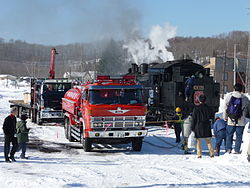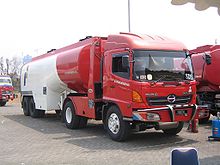Hino Ranger
| Hino Jidōsha Ranger | |
|---|---|
| Manufacturer: | Hino Jidōsha |
| Production period: | 1969– |
| Previous model: | |
| Successor: | |
The Hino Ranger is a medium to heavy forward control truck that Hino Motors has been producing since 1969. The Ranger is internally referred to as the Hino F-Series like FC, FD, FE, FF, FG, FL, and FM. The higher the letters, the higher the payload . Models with all-wheel drive are given the abbreviations FT and GT. The SG tractor units. Since 1999, the smaller models with lower payloads such as FA and FB have been replaced by the Hino Dutro , which is marketed in Japan and Europe as the Toyota Dyna . Hino has been taking part in the Dakar Rally with the 4WD FT Ranger truck since 1991 and has won the less than 10,000 cc class for 17 years in a row. In 1997 overall victory was achieved in the truck class. In North America , the name Ranger is not used, but the model is marketed as Hino FA, FB, FD, FE, FF or SG depending on the weight class . The smallest model starts there with a payload of 7.5 tonnes and a total weight of 15,000 kg.
1st generation (1964–1984)
| I. | |
|---|---|

|
|
| Production period: | 1964-1984 |
| Engines: |
Diesel engines : Hino DQ100 4.5-liter Hino EC100 5.0-liter |
In 1964 the first generation KM appeared with a 3.5 ton payload . With the introduction of the KL version from 1969, the KM also received its further model revisions, and from 1970 the 5.0-liter direct injection diesel engine Hino EC100 with 120 hp as an option . In 1977 the KM was extended to 4 and 4.5 tons payload to replace the Toyota Massy Dyna . The KM was produced until 1984 because the demand was very stable, especially in Indonesia .
2nd generation (1969–1980)
| II | |
|---|---|

|
|
| Production period: | 1969-1980 |
| Engines: |
Diesel engines : Hino EC100 5.0-liter with 120 HP Hino EH300 with 155 HP |
The Hino Ranger KL was introduced in Japan in 1969. The KL was an enlarged KM with a payload of 6 tons. In Australia , the series was marketed as the Toyota KL300 . The Ranger KL series was offered with a short wheelbase as KL300, KL340 / KL350 with a medium wheelbase and with a long wheelbase as KL360 / KL380. The new 5.0-liter diesel engine Hino EC100 with 120 hp was used as the engine.
- In contrast to the KM, it was also available with a double cab from 1970 and there were also three windscreen wipers as an option.
- In 1972 there was a small revision with a modified radiator grille and indicator lights. In addition, there was now also a 6 ton payload variant.
- From 1974 the Hino-EH300 diesel engine with turbocharger and 155 hp and optional all-wheel drive was available.
- In 1975 there was another small revision with a new radiator grille and a total of more chrome parts.
- In 1980 the production of the KL series was stopped.
3rd generation (1980-2003)
| III | |
|---|---|

|
|
| Production period: | 1980-2003 |
| Engines: |
Diesel engines : Hino EC100 Hino EH300 |
The third generation appeared in 1980. The engines were basically the same, but with more power. The payload variants now started at 3.5 tons. With the introduction of this series, the first generation was discontinued on the domestic market.
- In 1982, Hino signed a contract with Ford to supply the Ranger as a badge engineering model Ford N-Series. Ford replaced the Ford D-series in Oceania .
- In 1984 the engines were revised to comply with the new emission standards. At the same time, instead of round, square headlights were installed.
- In 1986 there were further minor revisions, including the introduction of standard central locking .
- Other small changes were made in 1988. The exterior of the radiator grille was now framed by white lines. At the same time, Kia Motors was now building the model under license in South Korea as the Kia Rhino , but with its own engines.
- In 1989 production in Japan was ended. The production facilities were brought to Indonesia, where the Super Ranger and Jumbo Ranger series were produced for the local market and other Asian countries such as India until 2003.
4th generation (1989-2001)
| IV | |
|---|---|

|
|
| Production period: | 1989-2001 |
| Engines: |
Diesel engines : Hino H07D Hino J05C, J07C, and J08C |
The 4th generation started in Japan in 1989. She was advertised there as a Cruising Ranger, Rising Ranger and Space Ranger. The engine used was the Hino H07D with exhaust gas recirculation in various power levels. The export model had four rectangular headlights instead of two rectangular ones. Rear air suspension was now optionally available and the optional all-wheel drive was now switched on electrically. The double cabin was now also available with a bunk instead of the second row of seats.
- From 1992 the freight versions had tubeless radial tires . CFC-free air conditioning and anti-lock braking systems were now available as options. In addition, a rear electronic parking aid as standard.
- In 1994 there were minor changes to the front with a new Hino emblem. The new emissions regulations brought a revision of the engines, including the introduction of a charge air cooler . The 3.5-ton variant was now also marketed in some markets as the Toyota FB until 1999 (in Europe as the Toyota Dyna ).
- In 1996 the J08C engine received common rail injection .
- From 1998 to the end of 2003, Kia Motors built the model again under license as the Kia Rhino.
- In 1999 a driver airbag was added to the standard equipment.
- In 2001 the production of the 4th generation was stopped.
5th generation (since 2001)
| V | |
|---|---|

|
|
| Production period: | 2001– |
| Engines: |
Diesel engines : Hino J05D, J07E, and J08E hybrid drive CNG |
The 5th generation, which has been built since 2001, is marketed in Japan as Ranger Pro for the lighter versions with a standard cab and Super Ranger for the heavier versions and wider cab. In export terms, the series is mostly called Hino 500, in Indonesia, where it has been produced since 2003, furthermore Super Ranger and Jumbo Ranger, in Malaysia Hino Validus and Hino Mega in Thailand . The Ranger Pro has a side window to allow the driver to observe the side of the vehicle. In addition to the driver's cabs of different widths, a high-roof version and a long-haul version with bed and refrigerator are now also available. A double cabin is only available for the Ranger Pro. For discerning customers there is the high-grade package with, among other things, chrome bumpers, xenon lights , and fittings and other interiors with wood paneling.
- The Super-Ranger has been equipped with air suspension as standard since 2003.
- In 2004, the engine range (Hino J05D, J07E, and J08E) was completely converted to common rail injection with charge air cooling and a turbocharger. At the same time, a hybrid drive version was introduced.
- Since 2005 the engines can also be operated with CNG .
- In 2007 the engines were revised and fuel consumption was reduced. An electronic immobilizer has been standard equipment ever since .
- In order to comply with future stricter emissions regulations, an electronic CVT transmission has been used in the hybrid model since 2008 instead of a mechanical automatic transmission .
- The engines have been delivered with lower pollutant emissions since 2011 and a special mirror on the front should make the area directly in front of the vehicle visible and prevent accidents with pedestrians.

